Winter Wheat Resistant to Increases in Rain and Snow Intensity in a Semi-Arid System
Abstract
1. Introduction
2. Materials and Methods
2.1. Site Description
2.2. Experimental Design
2.3. Treatment Responses
2.4. Analysis
3. Results
3.1. Soil Moisture Effects
3.2. Biotic Effects
4. Discussion
5. Conclusions
Supplementary Materials
Author Contributions
Funding
Data Availability Statement
Acknowledgments
Conflicts of Interest
Appendix A. Effects of Rainout Shelters
Appendix A.1. Shelter Effects on Temperature and Humidity
Appendix A.2. Shelter Effects on Vegetation
Appendix B. Description of Precipitation Intensity Treatments
- Water was applied to plots via drip irrigation lines once enough water was collected in the tanks to create a precipitation event of a certain size (which varied by treatment). The target precipitation event sizes were calculated using historical precipitation data and the Clausius–Clapeyron relation. For example, for the 2 mm treatment associated with 1 °C of warming, the following steps were used to calculate the target event size: historical observed daily precipitation was put in descending order.
- A curve was fit to this distribution of historical precipitation events to create a model of the precipitation distribution.
- Precipitation events in this generalized distribution were multiplied by 1.07 to create a new distribution of larger events.
- Enough of the smallest precipitation events were removed from this new distribution so that the sum of annual precipitation was equal to the sum of the original distribution (since all events were increased by 7%, if the smallest events were not “removed,” then total annual precipitation would necessarily also increase by 7%). This created a new distribution with fewer larger precipitation events, but the same total annual precipitation.
References
- UNESCO. United Nations World Water Development Report 2020: Water and Climate Change; UNESCO: Paris, France, 2020. [Google Scholar]
- Venkateswarlu, B.; Shanker, A.K. Dryland agriculture: Bringing resilience to Ccop production under changing climate. In Crop Stress and its Management: Perspectives and Strategies; Springer: Dordrecht, The Netherlands, 2012; pp. 19–44. ISBN 9789400722200. [Google Scholar]
- Stewart, B.A. Dryland Farming. In Reference Module in Food Science; Elsevier B.V.: Amsterdam, The Netherlands, 2016. [Google Scholar]
- Donat, M.G.; Lowry, A.L.; Alexander, L.V.; O’Gorman, P.A.; Maher, N. More extreme precipitation in the world’s dry and wet regions. Nat. Clim. Chang. 2016, 6, 508–513. [Google Scholar] [CrossRef]
- Fischer, E.M.; Knutti, R. Observed heavy precipitation increase confirms theory and early models. Nat. Clim. Chang. 2016, 6, 986–991. [Google Scholar] [CrossRef]
- Wilcox, K.R.; von Fischer, J.C.; Muscha, J.M.; Petersen, M.K.; Knapp, A.K. Contrasting above- and belowground sensitivity of three Great Plains grasslands to altered rainfall regimes. Glob. Chang. Biol. 2015, 21, 335–344. [Google Scholar] [CrossRef]
- Robinson, T.M.P.; Gross, K.L. The impact of altered precipitation variability on annual weed species. Am. J. Bot. 2010, 97, 1625–1629. [Google Scholar] [CrossRef]
- Fishman, R. More uneven distributions overturn benefits of higher precipitation for crop yields. Environ. Res. Lett. 2016, 11. [Google Scholar] [CrossRef]
- Smith, N.G.; Rodgers, V.L.; Brzostek, E.R.; Kulmatiski, A.; Avolio, M.L.; Hoover, D.L.; Koerner, S.E.; Grant, K.; Jentsch, A.; Fatichi, S.; et al. Toward a better integration of biological data from precipitation manipulation experiments into Earth system models. Rev. Geophys. 2014, 52, 412–434. [Google Scholar] [CrossRef]
- Holdrege, M.C.; Beard, K.H.; Kulmatiski, A. Woody plant growth increases with precipitation intensity in a cold semi-arid system. Ecology 2020, 1–11. [Google Scholar] [CrossRef]
- Gherardi, L.A.; Sala, O.E. Enhanced precipitation variability decreases grass- and increases shrub-productivity. Proc. Natl. Acad. Sci. USA 2015, 112, 12735–12740. [Google Scholar] [CrossRef] [PubMed]
- Heisler-White, J.L.; Blair, J.M.; Kelly, E.F.; Harmoney, K.; Knapp, A.K. Contingent productivity responses to more extreme rainfall regimes across a grassland biome. Glob. Chang. Biol. 2009, 15, 2894–2904. [Google Scholar] [CrossRef]
- Heisler-White, J.L.; Knapp, A.K.; Kelly, E.F. Increasing precipitation event size increases aboveground net primary productivity in a semi-arid grassland. Oecologia 2008, 158, 129–140. [Google Scholar] [CrossRef]
- Good, S.P.; Caylor, K.K. Climatological determinants of woody cover in Africa. Proc. Natl. Acad. Sci. USA 2011, 108, 4902–4907. [Google Scholar] [CrossRef] [PubMed]
- Case, M.F.; Staver, A.C. Soil texture mediates tree responses to rainfall intensity in African savannas. New Phytol. 2018, 219, 1363–1372. [Google Scholar] [CrossRef]
- Bodner, G.; Nakhforoosh, A.; Kaul, H.P. Management of crop water under drought: A review. Agron. Sustain. Dev. 2015, 35, 401–442. [Google Scholar] [CrossRef]
- Shortridge, J. Observed trends in daily rainfall variability result in more severe climate change impacts to agriculture. Clim. Chang. 2019, 157, 429–444. [Google Scholar] [CrossRef]
- Troy, T.J.; Kipgen, C.; Pal, I. The impact of climate extremes and irrigation on US crop yields. Environ. Res. Lett. 2015, 10. [Google Scholar] [CrossRef]
- Mearns, L.O.; Rosenzweig, C.; Goldberg, R. The effect of changes in daily and interannual climatic variability on CERES-Wheat: A sensitivity study. Clim. Chang. 1996, 32, 257–292. [Google Scholar] [CrossRef]
- Butler, E.E. Heavy rain, come today. Nat. Clim. Chang. 2020, 10, 805–806. [Google Scholar] [CrossRef]
- Rockström, J.; Karlberg, L.; Wani, S.P.; Barron, J.; Hatibu, N.; Oweis, T.; Bruggeman, A.; Farahani, J.; Qiang, Z. Managing water in rainfed agriculture-The need for a paradigm shift. Agric. Water Manag. 2010, 97, 543–550. [Google Scholar] [CrossRef]
- FAO. World Food and Agriculture—Statistical Yearbook 2020; FAO: Rome, Italy, 2020; ISBN 978-92-5-133394-5. [Google Scholar]
- Vocke, G.; Ali, M. US wheat production practices, costs, and yields: Variations across regions. USDA-ERS 2013, EIB-116, 1–30. [Google Scholar]
- Jensen, K.J.S.; Hansen, S.; Styczen, M.E.; Holbak, M.; Jensen, S.M.; Petersen, C.T. Yield and development of winter wheat (Triticum aestivum L.) and spring barley (Hordeum vulgare) in field experiments with variable weather and drainage conditions. Eur. J. Agron. 2021, 122, 126075. [Google Scholar] [CrossRef]
- Webber, H.; Ewert, F.; Olesen, J.E.; Müller, C.; Fronzek, S.; Ruane, A.C.; Bourgault, M.; Martre, P.; Ababaei, B.; Bindi, M.; et al. Diverging importance of drought stress for maize and winter wheat in Europe. Nat. Commun. 2018, 9, 1–10. [Google Scholar] [CrossRef]
- Li, X.; Troy, T.J. Changes in rainfed and irrigated crop yield response to climate in the western US. Environ. Res. Lett. 2018, 13, 064031. [Google Scholar] [CrossRef]
- Rezaei, E.E.; Siebert, S.; Ewert, F. Intensity of heat stress in winter wheat—Phenology compensates for the adverse effect of global warming. Environ. Res. Lett. 2015, 10. [Google Scholar] [CrossRef]
- Gooding, M.J.; Ellis, R.H.; Shewry, P.R.; Schofield, J.D. Effects of restricted water availability and increased temperature on the grain filling, drying and quality of winter wheat. J. Cereal Sci. 2003, 37, 295–309. [Google Scholar] [CrossRef]
- White, J.W. Comments on a report of regression-based evidence for impact of recent climate change on winter wheat yields. Agric. Ecosyst. Environ. 2009, 129, 547–548. [Google Scholar] [CrossRef]
- Sheehy, J.E.; Mitchell, P.L.; Ferrer, A.B. Decline in rice grain yields with temperature: Models and correlations can give different estimates. Field Crop. Res. 2006, 98, 151–156. [Google Scholar] [CrossRef]
- Patil, R.H.; Laegdsmand, M.; Olesen, J.E.; Porter, J.R. Growth and yield response of winter wheat to soil warming and rainfall patterns. J. Agric. Sci. 2010, 148, 553–566. [Google Scholar] [CrossRef]
- Tataw, J.T.; Baier, F.; Krottenthaler, F.; Pachler, B.; Schwaiger, E.; Wyhlidal, S.; Formayer, H.; Hösch, J.; Baumgarten, A.; Zaller, J.G. Climate change induced rainfall patterns affect wheat productivity and agroecosystem functioning dependent on soil types. Ecol. Res. 2016, 31, 203–212. [Google Scholar] [CrossRef]
- Drebenstedt, I.; Schmid, I.; Poll, C.; Marhan, S.; Kahle, R.; Kandeler, E.; Högy, P. Effects of soil warming and altered precipitation patterns on photosynthesis, biomass production and yield of barley. J. Appl. Bot. Food Qual. 2020, 93, 44–53. [Google Scholar] [CrossRef]
- Poll, C.; Marhan, S.; Back, F.; Niklaus, P.A.; Kandeler, E. Field-scale manipulation of soil temperature and precipitation change soil CO2 flux in a temperate agricultural ecosystem. Agric. Ecosyst. Environ. 2013, 165, 88–97. [Google Scholar] [CrossRef]
- Drebenstedt, I.; Hart, L.; Poll, C.; Marhan, S.; Kandeler, E.; Böttcher, C.; Meiners, T.; Hartung, J.; Högy, P. Do soil warming and changes in precipitation patterns affect seed yield and seed quality of field-grown winter oilseed rape? Agronomy 2020, 10, 520. [Google Scholar] [CrossRef]
- Menne, M.J.; Durre, I.; Vose, R.S.; Gleason, B.E.; Houston, T.G. An overview of the Global Historical Climatology Network-Daily Database. J. Atmos. Ocean. Technol. 2012, 29, 897–910. [Google Scholar] [CrossRef]
- Soil Survey Staff Natural Resrouces Conservation Service; United States Department of Agriculture. Web Soil Survey. Available online: https://websoilsurvey.sc.egov.usda.gov/ (accessed on 7 October 2018).
- Hodges, R.; Clawson, R.; Cardon, G.E. Soil Series: Elevation and Agricultural Soil Test Survey of the Godfrey Dryland Experimental Farm, Clarkston, Utah; Factsheet 1797; Utah State University Extension: Clarkston, UT, USA, 2017. [Google Scholar]
- Hole, D.J.; Dewey, W.; Albrechtsen, R.S. Registration of ‘Promontory’ Wheat. Crop. Sci. 1995, 35, 1206–1207. [Google Scholar] [CrossRef]
- Robertson, D.L.; Guy, S.O.; Brown, B.D. Southern Idaho Dryland Winter Wheat Production Guide; Extension Bulletin 827; University of Idaho: Moscow, ID, USA, 2004. [Google Scholar]
- Kulmatiski, A.; Beard, K.H. Woody plant encroachment facilitated by increased precipitation intensity. Nat. Clim. Chang. 2013, 3, 833–837. [Google Scholar] [CrossRef]
- O’Gorman, P.A.; Muller, C.J. How closely do changes in surface and column water vapor follow Clausius-Clapeyron scaling in climate change simulations? Environ. Res. Lett. 2010, 5. [Google Scholar] [CrossRef]
- Garbulsky, M.F.M.F.; Peñuelas, J.; Gamon, J.; Inoue, Y.; Filella, I.; Penuelas, J.; Gamon, J.; Inoue, Y.; Filella, I. The photochemical reflectance index (PRI) and the remote sensing of leaf, canopy and ecosystem radiation use efficiencies. A review and meta-analysis. Remote Sens. Environ. 2011, 115, 281–297. [Google Scholar] [CrossRef]
- Payero, J.O.; Irmak, S. Variable upper and lower crop water stress index baselines for corn and soybean. Irrig. Sci. 2006, 25, 21–32. [Google Scholar] [CrossRef]
- Bates, D.; Mächler, M.; Bolker, B.; Walker, S. Fitting linear mixed-effects models using lme4. J. Stat. Softw. 2015, 67, 1–48. [Google Scholar] [CrossRef]
- Wood, S.N. Fast stable restricted maximum likelihood and marginal likelihood estimation of semiparametric generalized linear models. J. R. Stat. Soc. Ser. B 2011, 73, 3–36. [Google Scholar] [CrossRef]
- Burnham, K.P.; Anderson, D.R. Model Selection and Inference: A Practical Information-Theoretic Approach, 2nd ed.; Springer: New York, NY, USA, 2002; ISBN 978-0-387-22456-5. [Google Scholar]
- R Core Team. R: A Language and Environment for Statistical Computing; R Foundation for Statistical Computing: Vienna, Austria, 2019. [Google Scholar]
- Iizumi, T.; Ramankutty, N. Changes in yield variability of major crops for 1981-2010 explained by climate change. Environ. Res. Lett. 2016, 11. [Google Scholar] [CrossRef]
- Ray, D.K.; Gerber, J.S.; Macdonald, G.K.; West, P.C. Climate variation explains a third of global crop yield variability. Nat. Commun. 2015, 6, 1–9. [Google Scholar] [CrossRef] [PubMed]
- Wilcox, J.; Makowski, D. A meta-analysis of the predicted effects of climate change on wheat yields using simulation studies. Field Crop. Res. 2014, 156, 180–190. [Google Scholar] [CrossRef]
- Knapp, A.K.; Beier, C.; Briske, D.D.; Classen, A.T.; Luo, Y.; Reichstein, M.; Smith, M.D.; Smith, S.D.; Bell, J.E.; Fay, P.A.; et al. Consequences of more extreme precipitation regimes for terrestrial ecosystems. Bioscience 2008, 58, 811–821. [Google Scholar] [CrossRef]
- Kulmatiski, A.; Adler, P.B.; Foley, K.M. Hydrologic niches explain species coexistence and abundance in a shrub-steppe system. J. Ecol. 2020, 108, 998–1008. [Google Scholar] [CrossRef]
- Berry, R.S.; Kulmatiski, A. A savanna response to precipitation intensity. PLoS ONE 2017, 12, 1–18. [Google Scholar] [CrossRef]
- Lopes, M.S.; Royo, C.; Alvaro, F.; Sanchez-Garcia, M.; Ozer, E.; Ozdemir, F.; Karaman, M.; Roustaii, M.; Jalal-Kamali, M.R.; Pequeno, D. Optimizing winter wheat resilience to climate change in rain fed crop systems of Turkey and Iran. Front. Plant Sci. 2018, 9, 1–14. [Google Scholar] [CrossRef]
- Blum, A. Effective use of water (EUW) and not water-use efficiency (WUE) is the target of crop yield improvement under drought stress. Field Crop. Res. 2009, 112, 119–123. [Google Scholar] [CrossRef]
- Fang, Y.; Du, Y.; Wang, J.; Wu, A.; Qiao, S.; Xu, B.; Zhang, S.; Siddique, K.H.M.; Chen, Y. Moderate drought stress affected root growth and grain yield in old, modern and newly released cultivars of winter wheat. Front. Plant Sci. 2017, 8, 1–14. [Google Scholar] [CrossRef]
- Barraclough, P.B.; Weir, A.H.; Kulhmann, H. Factors affecting the growth and distribution of winter wheat roots under UK field conditions. In Plant Roots and Their Environment; Elsevier Science Publishers B.V.: Amsterdam, The Netherlands, 1991; Volume 24, pp. 410–417. [Google Scholar]
- Itoh, H.; Hayashi, S.; Nakajima, T.; Hayashi, T.; Yoshida, H.; Yamazaki, K.; Komatsu, T. Effects of soil type, vertical root distribution and precipitation on grain yield of winter wheat. Plant Prod. Sci. 2009, 12, 503–513. [Google Scholar] [CrossRef][Green Version]
- Hodgkinson, L.; Dodd, I.C.; Binley, A.; Ashton, R.W.; White, R.P.; Watts, C.W.; Whalley, W.R. Root growth in field-grown winter wheat: Some effects of soil conditions, season and genotype. Eur. J. Agron. 2017, 91, 74–83. [Google Scholar] [CrossRef]
- Grant, K.; Kreyling, J.; Dienstbach, L.F.H.; Beierkuhnlein, C.; Jentsch, A. Water stress due to increased intra-annual precipitation variability reduced forage yield but raised forage quality of a temperate grassland. Agric. Ecosyst. Environ. 2014, 186, 11–22. [Google Scholar] [CrossRef]
- Grant, K.; Kreyling, J.; Beierkuhnlein, C.; Jentsch, A. Importance of seasonality for the response of a mesic temperate grassland to increased precipitation variability and warming. Ecosystems 2017, 20, 1454–1467. [Google Scholar] [CrossRef]
- Fay, P.A.; Blair, J.M.; Smith, M.D.; Nippert, J.B.; Carlisle, J.D.; Knapp, A.K. Relative effects of precipitation variability and warming on tallgrass prairie ecosystem function. Biogeosciences 2011, 8, 3053–3068. [Google Scholar] [CrossRef]
- Nippert, J.B.; Knapp, A.K.; Briggs, J.M. Intra-annual rainfall variability and grassland productivity: Can the past predict the future? Plant Ecol. 2006, 184, 65–74. [Google Scholar] [CrossRef]
- Asseng, S.; Ewert, F.; Rosenzweig, C.; Jones, J.W.; Hatfield, J.L.; Ruane, A.C.; Boote, K.J.; Thorburn, P.J.; Rötter, R.P.; Cammarano, D.; et al. Uncertainty in simulating wheat yields under climate change. Nat. Clim. Chang. 2013, 3, 827–832. [Google Scholar] [CrossRef]
- Richter, G.M.; Semenov, M.A. Modelling impacts of climate change on wheat yields in England and Wales: Assessing drought risks. Agric. Syst. 2005, 84, 77–97. [Google Scholar] [CrossRef]
- Walter, J.; Grant, K.; Beierkuhnlein, C.; Kreyling, J.; Weber, M.; Jentsch, A. Increased rainfall variability reduces biomass and forage quality of temperate grassland largely independent of mowing frequency. Agric. Ecosyst. Environ. 2012, 148, 1–10. [Google Scholar] [CrossRef]
- DuPont, S.T.; Beniston, J.; Glover, J.D.; Hodson, A.; Culman, S.W.; Lal, R.; Ferris, H. Root traits and soil properties in harvested perennial grassland, annual wheat, and never-tilled annual wheat. Plant Soil 2014, 381, 405–420. [Google Scholar] [CrossRef]
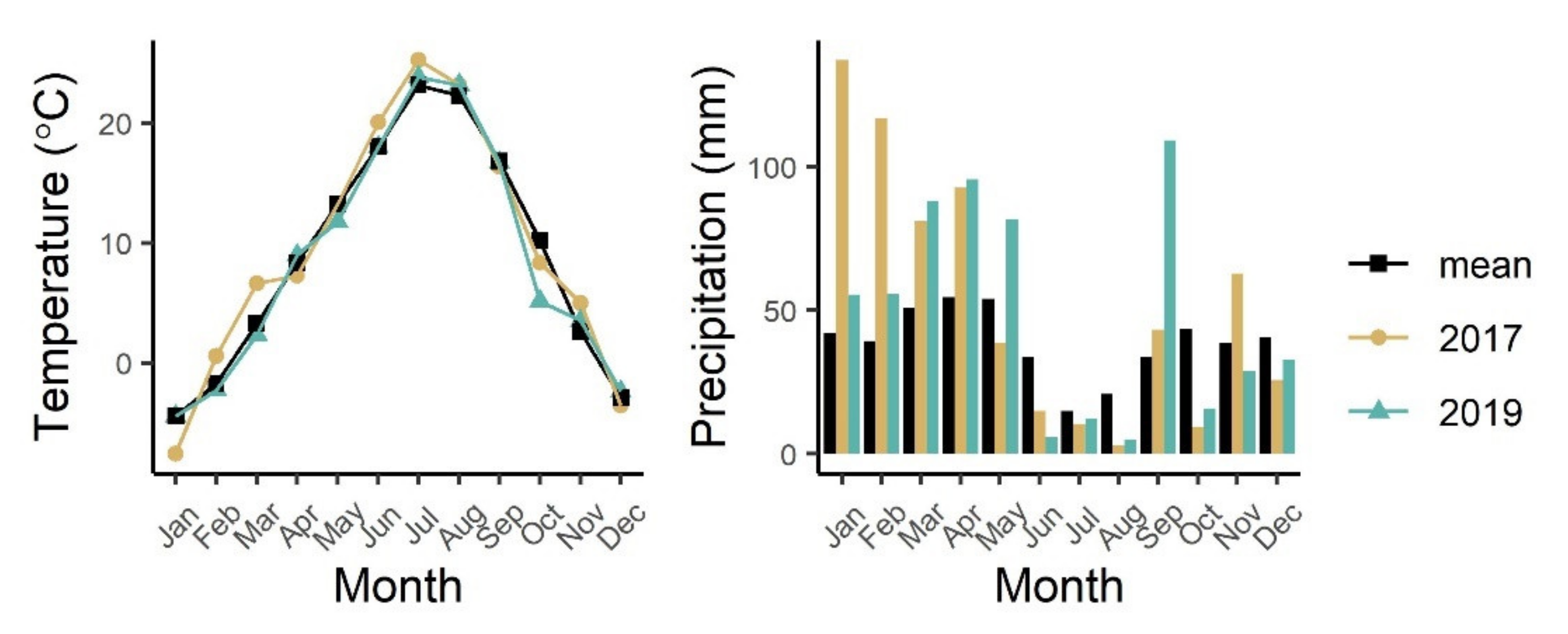
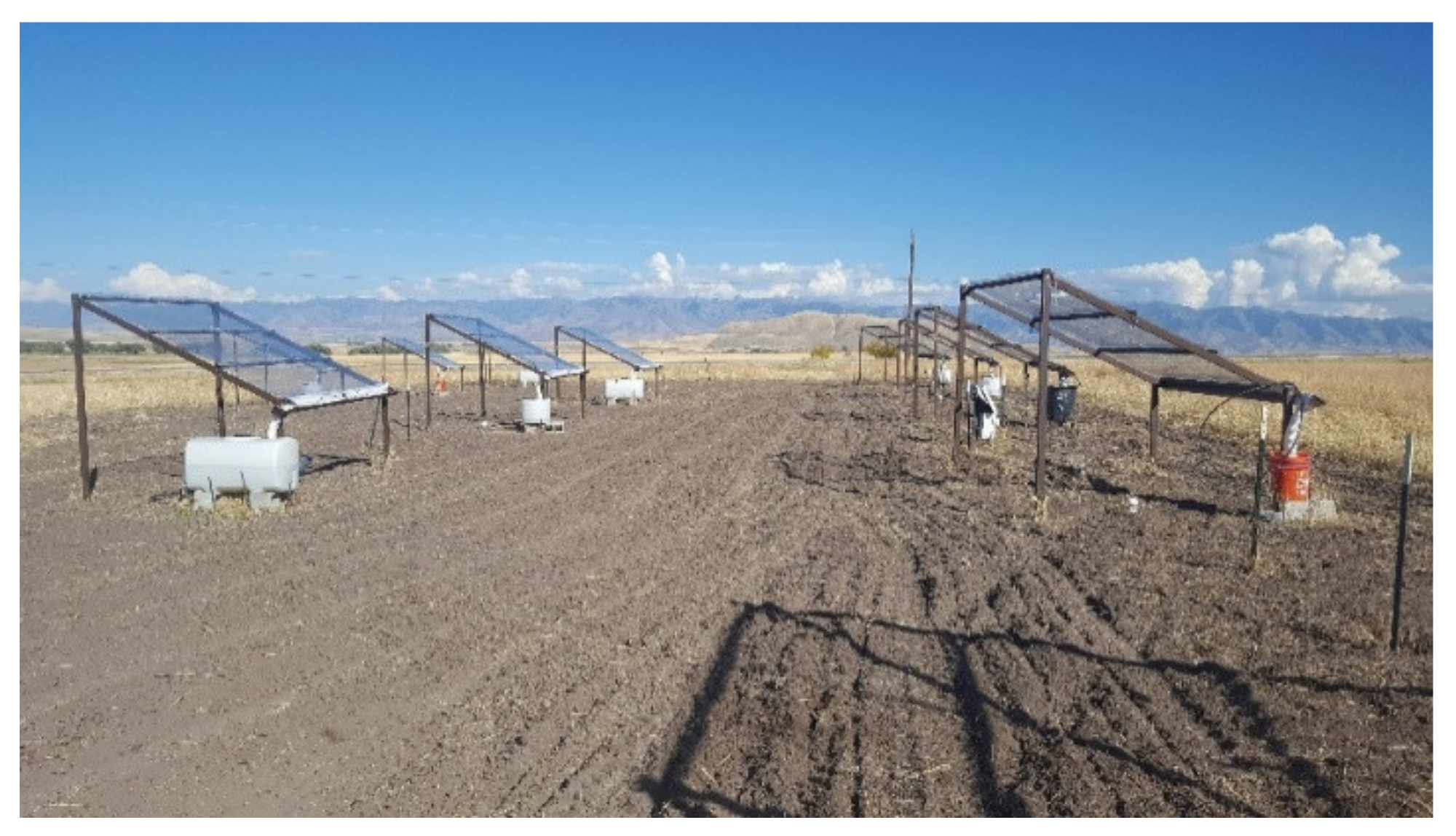
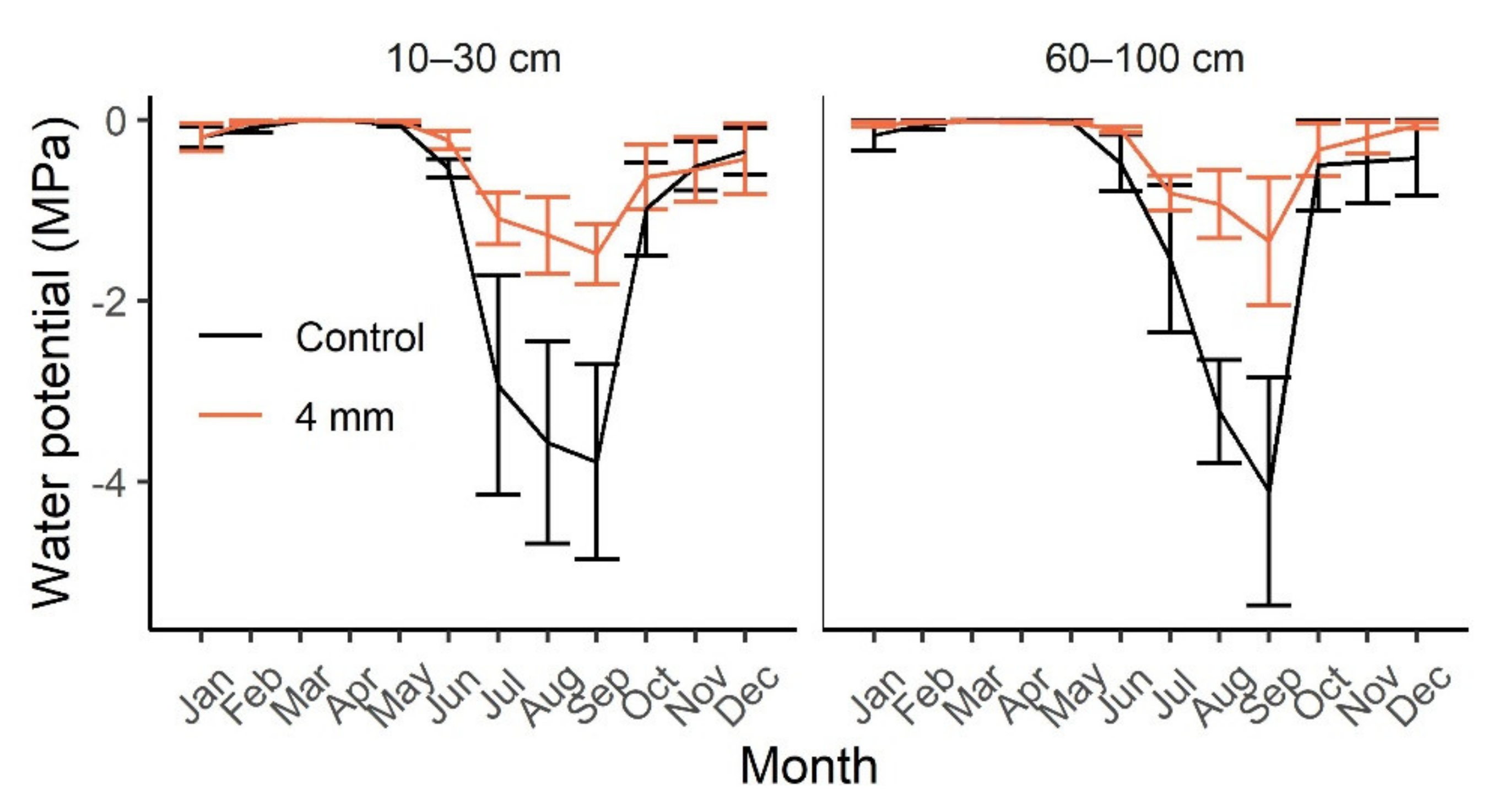
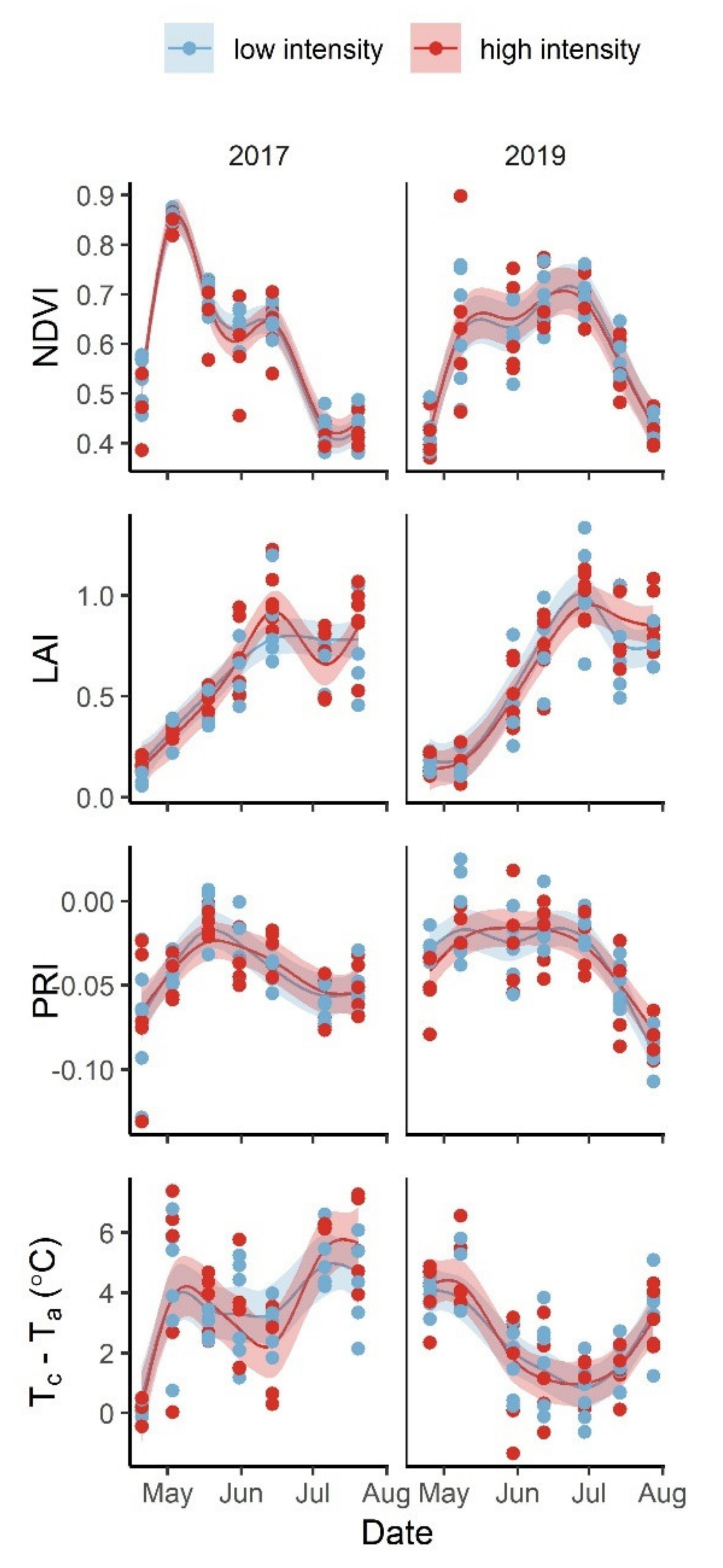
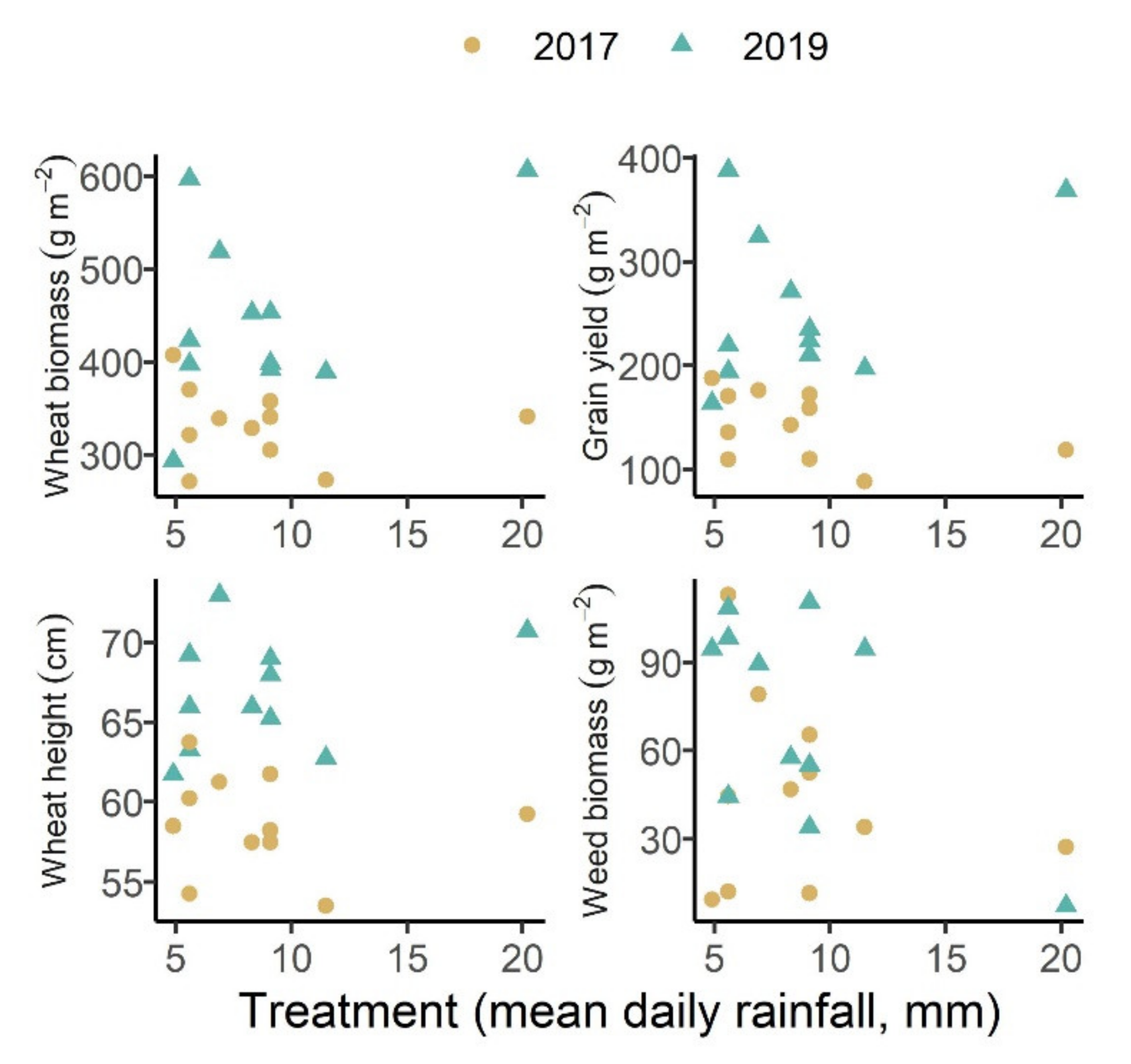
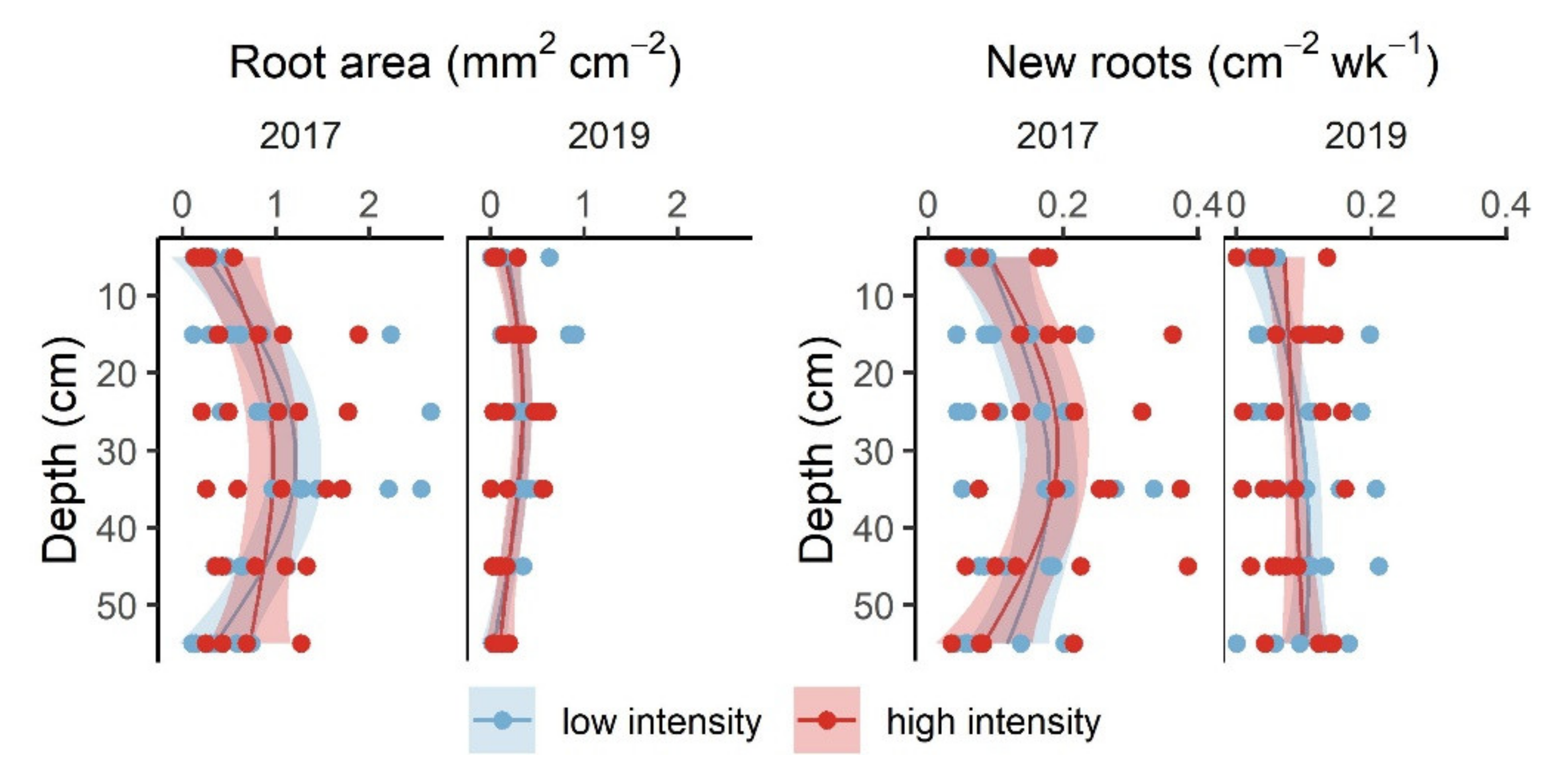
| Treatments | Description | N | Mean Daily Rainfall (mm) | Intensity Category |
|---|---|---|---|---|
| Shelterless control | Ambient plot (no rainout shelter) | 3 | 5.6 | |
| 1 mm | Received more frequent, small events than control plots. | 1 | 4.9 | Low intensity |
| Control | Sheltered-control plot, water was redeposited immediately after being collected from the shelter roof. | 3 | 5.6 | Low intensity |
| 2 mm | Water was redeposited once enough rainwater was collected in the tank to create a 2 mm event. | 1 | 6.9 | Low intensity |
| 3 mm | Water was redeposited once enough rainwater was collected in the tank to create a 3 mm event. | 1 | 8.3 | Low intensity |
| 4 mm | Water was redeposited once enough rainwater was collected in the tank to create a 4 mm event. | 3 | 9.1 | High intensity |
| 8 mm | Water was redeposited once enough rainwater was collected in the tank to create an 8 mm event. | 1 | 11.5 | High intensity |
| 18 mm | Water was redeposited once enough rainwater was collected in the tank to create an 18 mm event. | 1 | 20.5 | High intensity |
Publisher’s Note: MDPI stays neutral with regard to jurisdictional claims in published maps and institutional affiliations. |
© 2021 by the authors. Licensee MDPI, Basel, Switzerland. This article is an open access article distributed under the terms and conditions of the Creative Commons Attribution (CC BY) license (https://creativecommons.org/licenses/by/4.0/).
Share and Cite
Holdrege, M.C.; Beard, K.H.; Kulmatiski, A. Winter Wheat Resistant to Increases in Rain and Snow Intensity in a Semi-Arid System. Agronomy 2021, 11, 751. https://doi.org/10.3390/agronomy11040751
Holdrege MC, Beard KH, Kulmatiski A. Winter Wheat Resistant to Increases in Rain and Snow Intensity in a Semi-Arid System. Agronomy. 2021; 11(4):751. https://doi.org/10.3390/agronomy11040751
Chicago/Turabian StyleHoldrege, Martin C., Karen H. Beard, and Andrew Kulmatiski. 2021. "Winter Wheat Resistant to Increases in Rain and Snow Intensity in a Semi-Arid System" Agronomy 11, no. 4: 751. https://doi.org/10.3390/agronomy11040751
APA StyleHoldrege, M. C., Beard, K. H., & Kulmatiski, A. (2021). Winter Wheat Resistant to Increases in Rain and Snow Intensity in a Semi-Arid System. Agronomy, 11(4), 751. https://doi.org/10.3390/agronomy11040751






